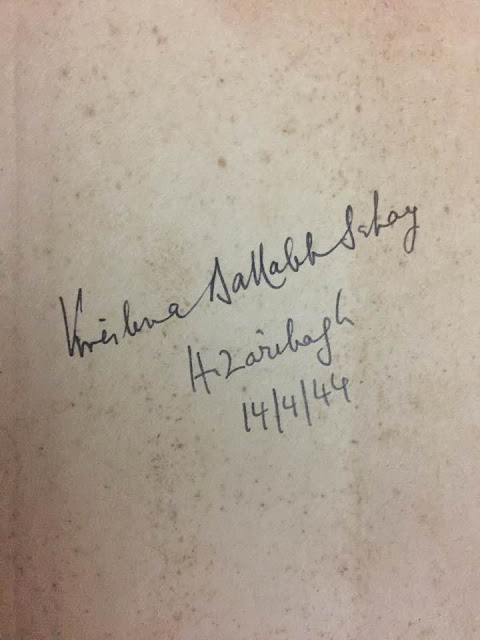11th January-55 years
back on this day India lost its most beloved Prime Minister Lal Bahadur Shastri
in the cold climes of an alien land faraway in Tashkent. Shastri was Prime
Minister of India for just 17 odd months but this diminutive figure made this
short tenure one of the most eventful years of a fledgeling democracy which
regained its lost pride when it emerged victorious in the 1965 war with
Pakistan. After Nehru’s exit, India was at crossroads, when Lal Bahadur Shastri
took over as the Prime Minister of India on 9th June 1964 at
this crucial juncture. It goes to the credit of Shastri’s leadership that India
moved ahead with confidence and vigour. His slogan ‘Jai Jawan Jai Kisaan’,
brought Shastri closer to Krishna Ballabh Sahay-the architect of land reforms
in independent India, a leader looked upon as their hope by the cultivating
class. Just a year back i.e. in 1963 the National Development Council (NDC) in
its meeting of the Mid-Term Appraisal of
the Third Five Year Plan had reviewed the progress made in the implementation
of land reforms where it was emphasized that speedy execution of the programme
of land reforms was vital for increasing agricultural production and
strengthening the rural economy. On the recommendations of the National
Development Council, the Land Reforms Implementation Committee (LRIC) was
constituted. This was chaired by the Home Minister Gulzari Lal Nanda. K. B.
Sahay was one of the five-member Chief Ministers in this Committee.
The recommendations of the LRIC, which is available on the
internet, were mostly made up of remarks and observations made by K.B. Sahay
during the meetings. This was K.B. Sahay’s second innings at ushering in land
reforms. He took up the assignment in right earnest and moved ahead swiftly to
bring about the changes that had remained incomplete due to his defeat in 1957
Assembly elections. Though K. B. Sahay did win the 1962 Assembly elections,
Binodanand Jha did not assign him the Department of Revenue, deliberately. K.B.
Sahay was bent upon completing the unfinished task of land reforms which included
the implementation of land ceiling legislation in letter and spirit and
updating the land records by entering the rights of the under-raiyats in
the land revenue records. These radical recommendations alerted K.B. Sahay’s
adversaries who united under the leadership of Binodanand Jha. They made all
efforts to denigrate K. B. Sahay and demanded an enquiry against him on charges
of alleged omission and commission.
The Express-News Service reported on
December 3, 1964, that a careful examination of allegations against the Chief
Ministers of Mysore and Bihar showed that they were devoid of substance. Though
a preliminary review of the charges against K. B. Sahay did not lead to a prima
facie case, Prime Minister Lal Bahadur Shastri and the Home Minister
Gulzari Lal Nanda decided to entrust the investigation of allegations against
them to the same Special Cabinet Committee originally set-up to investigate
into Orissa affair. The decision was taken to avoid any impression of
discrimination against Biju Patnaik and Biren Mitra on the one hand and S.
Nijalingappa and K. B. Sahay, Chief Ministers of Mysore and Bihar respectively,
on the other.
The Cabinet Sub-Committee gave a clean chit to K. B. Sahay and his cabinet colleagues. In its report, the Committee held that the charges had been based more on procedural lapses rather than on any serious departure from high standards of conduct. No concrete instance of corruption could be found by the Committee. In a Press conference on January 20, 1965, the then Prime Minister Lal Bahadur Shastri informed that the Government had received the Report and he would announce it ‘perhaps soon’.
However, the opposition did not rest at that. Their leader Bhola Paswan Singh went ahead and submitted a memorandum to the then, President Dr S. Radhakrishnan questioning even the integrity of Lal Bahadur Shastri. The memorandum read ‘The reported findings of the Union Cabinet Sub-Committee that no prima-facie case existed against K. B. Sahay have aroused suspicion in the public mind. The Prime Minister is so tied up with the Bihar Chief Minister that any good conduct certificate to K. B. Sahay on the political level has no meaning’. The delegation of opposition leaders demanded a judicial enquiry.
A judicial enquiry was indeed constituted against K. B. Sahay by his political opponents after Sahay had vacated the seat of Chief Minister in March 1967. K. B. Sahay stood on the weakest ground at that stage. The Commission of Enquiry was constituted with the mischievous motive of writing off his political obituary. The findings of the Commission were announced in 1971. These weren’t much different than those already pointed out by the Cabinet Sub-Committee. But such allegations and subsequent enquiry caused immense damage to K.B. Sahay’s image of a clean politician. As regards Lal Bahadur Shastri, he did not live to see his integrity being restored in the face of wild allegations by an irresponsible opposition. ‘Character assassination’ of a popular national figure, after all, had become the favourite pastime of political creed in those days. Unfortunately, we are witness to this cult of dwarfism even in the present times.








No comments:
Post a Comment